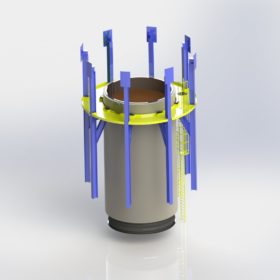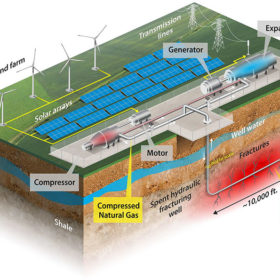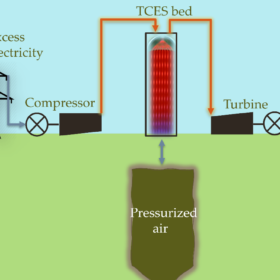Compressed air storage vs. lead-acid batteries
Researchers in the United Arab Emirates have compared the performance of compressed air storage and lead-acid batteries in terms of energy stored per cubic meter, costs, and payback period. They found the former has a considerably lower Capex and a payback time of only two years.
Hybridizing compressed air, thermal energy storage in post mining infrastructure
Scientists in Poland have developed a compressed air energy storage technology using a thermal energy storage (TES) system built into a disused mine shaft. The system works without external heat sources, and utilizes an air compressor, a compressed air reservoir with a built-in thermal energy storage system, and an air expander.
China’s first salt cavern for compressed air energy storage goes online
Huaneng Group has finished building a 300 MWh storage project in Changzhou, in China’s Jiangsu province. The state-owned company has already started operating the facility, which is situated in a salt cavern.
Storing renewables in depleted oil and gas wells
US researchers have proposed the use of hydraulically fractured oil and gas wells to store renewable energy via compressed natural gas, with the levelized cost of storage potentially coming in at $70/MWh and $270/MWh. They said wells could also be used to store other renewable gases such as carbon dioxide or hydrogen in the future.
Improving compressed air energy storage efficiency via chemical reactions
Scientists in the United States have proposed to use a thermochemical energy storage (TCES) technique that stores energy in chemical bonds to recover the heat produced during air compression operations. According to them, this innovation may increase the round-trip efficiency of compressed air energy storage to 60%.
Goldman Sachs invests $250 million in Hydrostor to advance compressed air energy storage projects
The investment is planned to support development and construction of Hydrostor’s 1.1GW, 8.7GWh of Advanced Compressed Air Energy Storage projects that are well underway in California and Australia, and help expand Hydrostor’s project development pipeline globally.
Hydrostor plans 400 MW / 3200 MWh compressed air energy storage in the U.S.
The plant would be able to deliver 400 MW of electricity for 8 hours, and would be comparable in size to some of California’s largest fossil fuel power plants.
Compressed-air storage for commercial applications
Israel-based Augwind has built its first 250 kW/1 MWh compressed air storage system for the collective community of Yahel, in the southern, desert part of the country. The commercial scale facility will be connected to a PV system and will be used for behind-the-meter services.
‘The chance to reset with a green recovery has now been lost’
Norwegian consultancy DNV today published the latest of its annual surveys of the state of the energy transition and lamented the fact so very little has been achieved during the last five years. We are forging ahead into a world that will be 2.3C hotter this century, predicts the report.
Australian utility tests compressed air storage
Compressed air energy storage is not exactly a new technology, but recent months have seen it get a new lease on life, as intermittent renewable sources of energy come to the fore.










